Numerical Simulation of Haze-Fog Particle Dispersion in the Typical Urban Community by Using Discrete Phase Model
Abstract
1. Introduction
2. Numerical Method
2.1. Flow Fundamental Governing Equation and Turbulence Model
2.2. Motion Equation and Turbulent Dispersion of Particles
3. Geometric Model and Boundary Conditions
3.1. Geometric Model
3.2. Boundary Conditions
4. Mesh Independence
5. Results and Discussion
5.1. Wake Characteristics around the Building Group
5.2. Particle Dispersion Analysis
5.2.1. Particle Dispersion on the Vertical Plane
5.2.2. Particle Dispersion on the Horizontal Plane
6. Conclusions
- (1)
- For the wake characteristics around the building group, the Hairpin vortex is clearly identified behind the building group. In the typical vertical planes, open cavity flow is formed by the ground, and the front and rear buildings, and then the primary vortex, secondary vortex are generated in the square cavities. In the horizontal planes, except the steady flow, two main flow types are identified in the present study, including ‘single body’ wake pattern and vortex impingement wake pattern.
- (2)
- For the haze-fog particle dispersion, it is further verified that the particle dispersion is dominated by the incoming wind flow. The high speed fluid carries a large number of particles rapidly through the streamwise street, while the low speed fluid from the slopping street carries a large number of particles into the re-circulation zone, resulting in the low concentration region of the particles to keep away from the building.
- (3)
- The distribution of vortex and its motion state play an important role in the distribution of particles. For the vertical planes, the primary vortex, secondary vortex formed in the open cavity make it difficult for the particles entered the square cavity to flow out. In the horizontal planes, vortices attached to the rear of the building have less interaction with the external fluid, resulting in a relatively low concentration of particle in this area.
Author Contributions
Funding
Acknowledgments
Conflicts of Interest
Abbreviations
| DDES | Delayed Detached-eddy Simulation |
| DPM | Discrete Phase Model |
| CFD | Computational Fluid Dynamics |
| RANS | Reynolds-averaged Navier Stokes |
| LES | Large-eddy Simulation |
References
- Logue, J.M.; Price, P.N.; Sherman, M.H.; Singer, B.C. A method to estimate the chronic health impact of air pollutants in US residences. Environ. Health Perspect. 2012, 120, 216–222. [Google Scholar] [CrossRef] [PubMed]
- World Health Organization. WHO Global Ambient Air Quality Database (Update 2018); World Health Organization: Geneva, Switzerland, 2018. [Google Scholar]
- Escobedo, F.J.; Kroeger, T.; Wagner, J.E. Urban forests and pollution mitigation: Analyzing ecosystem services and disservices. Environ. Pollut. 2011, 159, 2078–2087. [Google Scholar] [CrossRef] [PubMed]
- Li, X.X.; Leung, D.Y.; Liu, C.H.; Lam, K.M. Physical modeling of flow field inside urban street canyons. J. Appl. Meteorol. Climatol. 2008, 47, 2058–2067. [Google Scholar] [CrossRef]
- Gromke, C.; Ruck, B. Influence of trees on the dispersion of pollutants in an urban street canyon–experimental investigation of the flow and concentration field. Atmos. Environ. 2007, 41, 3287–3302. [Google Scholar] [CrossRef]
- Di Sabatino, S.; Buccolieri, R.; Pappaccogli, G.; Leo, L.S. The effects of trees on micrometeorology in a real street canyon: Consequences for local air quality. Int. J. Environ. Pollut. 2015, 58, 100–111. [Google Scholar] [CrossRef]
- Meroney, R.N.; Derickson, R. Virtual reality in wind engineering: The windy world within the computer. J. Wind Eng. 2014, 11, 11–26. [Google Scholar]
- Jeanjean, A.; Monks, P.; Leigh, R. Modelling the effectiveness of urban trees and grass on PM2.5 reduction via dispersion and deposition at a city scale. Atmos. Environ. 2016, 147, 1–10. [Google Scholar] [CrossRef]
- Cui, D.; Mak, C.M.; Ai, Z.; Kwok, K.C.; Meng, X.; Niu, J. On-site evaluation of pedestrian-level air quality at a U-type street canyon in an ancient city. J. Wind Eng. Ind. Aerodyn. 2017, 168, 322–333. [Google Scholar] [CrossRef]
- Lateb, M.; Meroney, R.N.; Yataghene, M.; Fellouah, H.; Saleh, F.; Boufadel, M. On the use of numerical modelling for near-field pollutant dispersion in urban environments—A review. Environ. Pollut. 2016, 208, 271–283. [Google Scholar] [CrossRef]
- Xue, F.; Li, X. The impact of roadside trees on traffic released PM10 in urban street canyon: Aerodynamic and deposition effects. Sustain. Cities Soc. 2017, 30, 195–204. [Google Scholar] [CrossRef]
- Schatzmann, M.; Leitl, B. Issues with validation of urban flow and dispersion CFD models. J. Wind Eng. Ind. Aerodyn. 2011, 99, 169–186. [Google Scholar] [CrossRef]
- Hajra, B.; Stathopoulos, T.; Bahloul, A. The effect of upstream buildings on near-field pollutant dispersion in the built environment. Atmos. Environ. 2011, 45, 4930–4940. [Google Scholar] [CrossRef]
- Hajra, B.; Stathopoulos, T.; Bahloul, A. Performance of ASHRAE models in assessing pollutant dispersion from rooftop emissions. HVAC&R Res. 2014, 20, 72–79. [Google Scholar]
- Stathopoulos, T.; Hajra, B. Wind-Induced Dispersion of Pollutants in the Urban Environment. In Advanced Environmental Wind Engineering; Springer: Kanagawa, Japan, 2016; pp. 129–147. [Google Scholar]
- Montazeri, H.; Blocken, B. CFD simulation of wind-induced pressure coefficients on buildings with and without balconies: Validation and sensitivity analysis. Build. Environ. 2013, 60, 137–149. [Google Scholar] [CrossRef]
- Buccolieri, R.; Jeanjean, A.P.; Gatto, E.; Leigh, R.J. The impact of trees on street ventilation, NOx and PM2.5 concentrations across heights in Marylebone Rd street canyon, central London. Sustain. Cities Soc. 2018, 41, 227–241. [Google Scholar] [CrossRef]
- Taleghani, M.; Clark, A.; Swan, W.; Mohegh, A. Air pollution in a microclimate; the impact of different green barriers on the dispersion. Sci. Total Environ. 2020, 711, 134649. [Google Scholar] [CrossRef]
- He, L.; Hang, J.; Wang, X.; Lin, B.; Li, X.; Lan, G. Numerical investigations of flow and passive pollutant exposure in high-rise deep street canyons with various street aspect ratios and viaduct settings. Sci. Total Environ. 2017, 584, 189–206. [Google Scholar] [CrossRef]
- Gousseau, P.; Blocken, B.; Stathopoulos, T.; Van Heijst, G. CFD simulation of near-field pollutant dispersion on a high-resolution grid: A case study by LES and RANS for a building group in downtown Montreal. Atmos. Environ. 2011, 45, 428–438. [Google Scholar] [CrossRef]
- Wang, M.; Lin, C.H.; Chen, Q. Determination of particle deposition in enclosed spaces by Detached Eddy Simulation with the Lagrangian method. Atmos. Environ. 2011, 45, 5376–5384. [Google Scholar] [CrossRef]
- Rashidi, S.; Esfahani, J.A.; Ellahi, R. Convective heat transfer and particle motion in an obstructed duct with two side by side obstacles by means of DPM model. Appl. Sci. 2017, 7, 431. [Google Scholar] [CrossRef]
- Salamon, P.; Fernàndez-Garcia, D.; Gómez-Hernández, J.J. A review and numerical assessment of the random walk particle tracking method. J. Contam. Hydrol. 2006, 87, 277–305. [Google Scholar] [CrossRef] [PubMed]
- Wang, X.; Lei, H.; Han, Z.; Zhou, D.; Shen, Z.; Zhang, H.; Zhu, H.; Bao, Y. Three-dimensional delayed detached-eddy simulation of wind flow and particle dispersion in the urban environment. Atmos. Environ. 2019, 201, 173–189. [Google Scholar] [CrossRef]
- Vervoort, R.; Blocken, B.; van Hooff, T. Reduction of particulate matter concentrations by local removal in a building courtyard: Case study for the Delhi American Embassy School. Sci. Total Environ. 2019, 686, 657–680. [Google Scholar] [CrossRef] [PubMed]
- Sheng, Q.; Zhang, Y.; Zhu, Z.; Li, W.; Xu, J.; Tang, R. An experimental study to quantify road greenbelts and their association with PM2. 5 concentration along city main roads in Nanjing, China. Sci. Total Environ. 2019, 667, 710–717. [Google Scholar] [CrossRef] [PubMed]
- Ounis, H.; Ahmadi, G.; McLaughlin, J.B. Brownian diffusion of submicrometer particles in the viscous sublayer. J. Colloid Interface Sci. 1991, 143, 266–277. [Google Scholar] [CrossRef]
- Zhao, B.; Yang, C.; Yang, X.; Liu, S. Particle dispersion and deposition in ventilated rooms: Testing and evaluation of different Eulerian and Lagrangian models. Build. Environ. 2008, 43, 388–397. [Google Scholar] [CrossRef]
- Van Hooff, T.; Blocken, B. Coupled urban wind flow and indoor natural ventilation modelling on a high-resolution grid: A case study for the Amsterdam ArenA stadium. Environ. Model. Softw. 2010, 25, 51–65. [Google Scholar] [CrossRef]
- Yoshie, R.; Mochida, A.; Tominaga, Y.; Kataoka, H.; Harimoto, K.; Nozu, T.; Shirasawa, T. Cooperative project for CFD prediction of pedestrian wind environment in the Architectural Institute of Japan. J. Wind Eng. Ind. Aerodyn. 2007, 95, 1551–1578. [Google Scholar] [CrossRef]
- Liu, J.; Niu, J. CFD simulation of the wind environment around an isolated high-rise building: An evaluation of SRANS, LES and DES models. Build. Environ. 2016, 96, 91–106. [Google Scholar] [CrossRef]
- Holmes J., D. Wind Loading of Structure; Spaon Press: London, UK, 2018. [Google Scholar]
- Ministry of Construction. Load Code for the Design of Building Structure; China Building Industry Press: Beijing, China, 2012. (In Chinese) [Google Scholar]
- Architectural Institute of Japan. Chapter 6 WIND LOADS. In Recommendations for Loading on Buildings; Architectural Institute of Japan: Tokyo, Japan, 2004; pp. 1–56. [Google Scholar]
- Bovand, M.; Rashidi, S.; Ahmadi, G.; Esfahani, J.A. Effects of trap and reflect particle boundary conditions on particle transport and convective heat transfer for duct flow-A two-way coupling of Eulerian-Lagrangian model. Appl. Therm. Eng. 2016, 108, 368–377. [Google Scholar] [CrossRef]
- Zhang, H.; Wang, F.; Wang, Y.; Wang, H. CFD Simulation of Cooking Particle Distribution and Motion. Procedia Eng. 2017, 205, 1800–1806. [Google Scholar] [CrossRef]
- Spalart, P.R.; Streett, C. Young-Person’s Guide to Detached-Eddy Simulation Grids; Technical Report NASA/CR-2001-211032; NASA: Washington, DC, USA, 2001.
- Zhu, H.; Wang, R.; Bao, Y.; Zhou, D.; Ping, H.; Han, Z.; Sherwin, S.J. Flow over a symmetrically curved circular cylinder with the free stream parallel to the plane of curvature at low Reynolds number. J. Fluids Struct. 2019, 87, 23–38. [Google Scholar] [CrossRef]
- Zhu, H.; Zhou, D.; Bao, Y.; Wang, R.; Lu, J.; Fan, D.; Han, Z. Wake characteristics of stationary catenary risers with different incoming flow directions. Ocean Eng. 2018, 167, 142–155. [Google Scholar] [CrossRef]

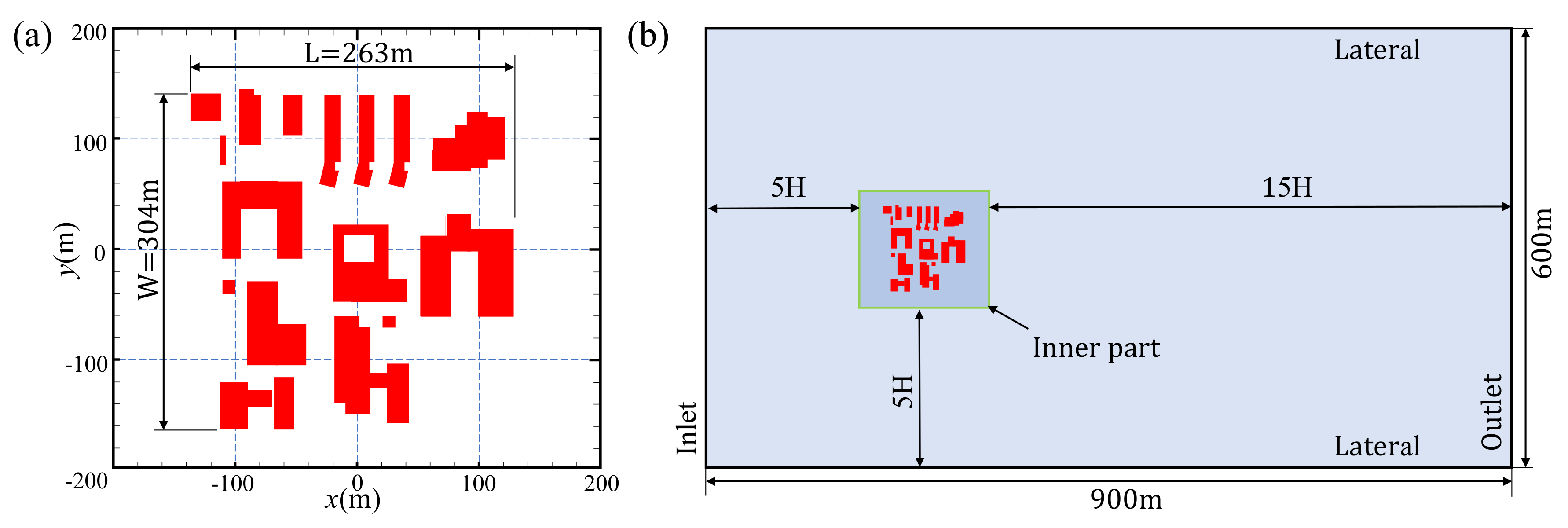
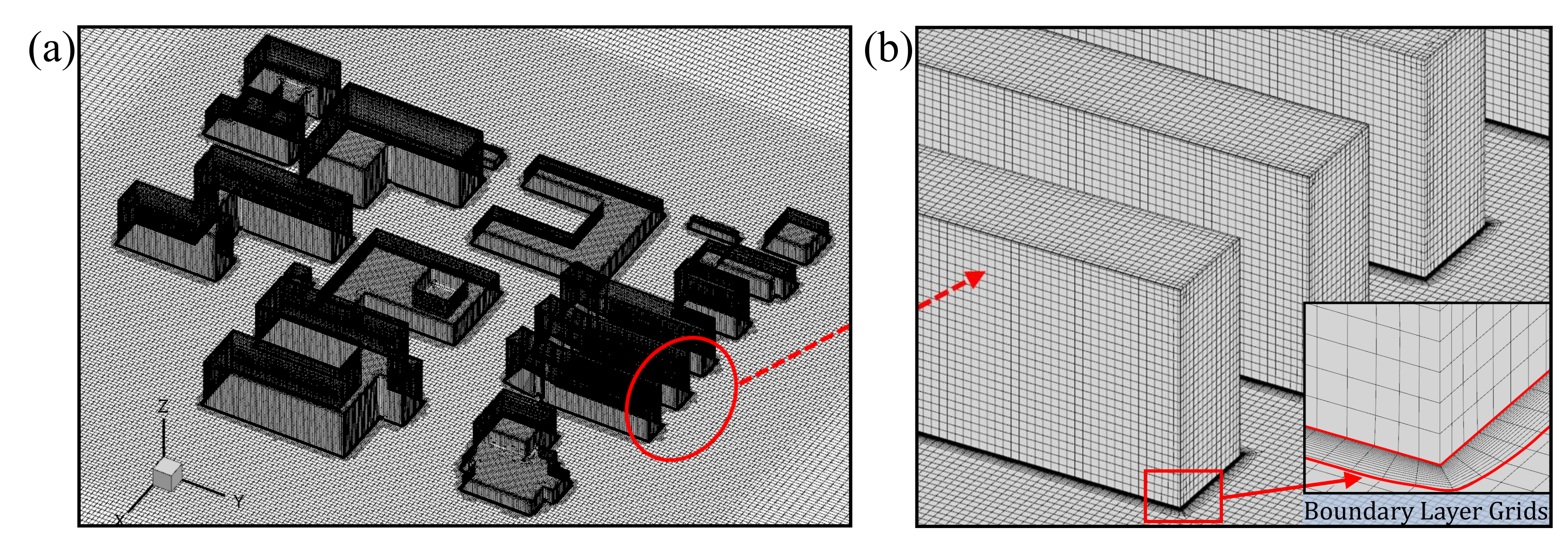
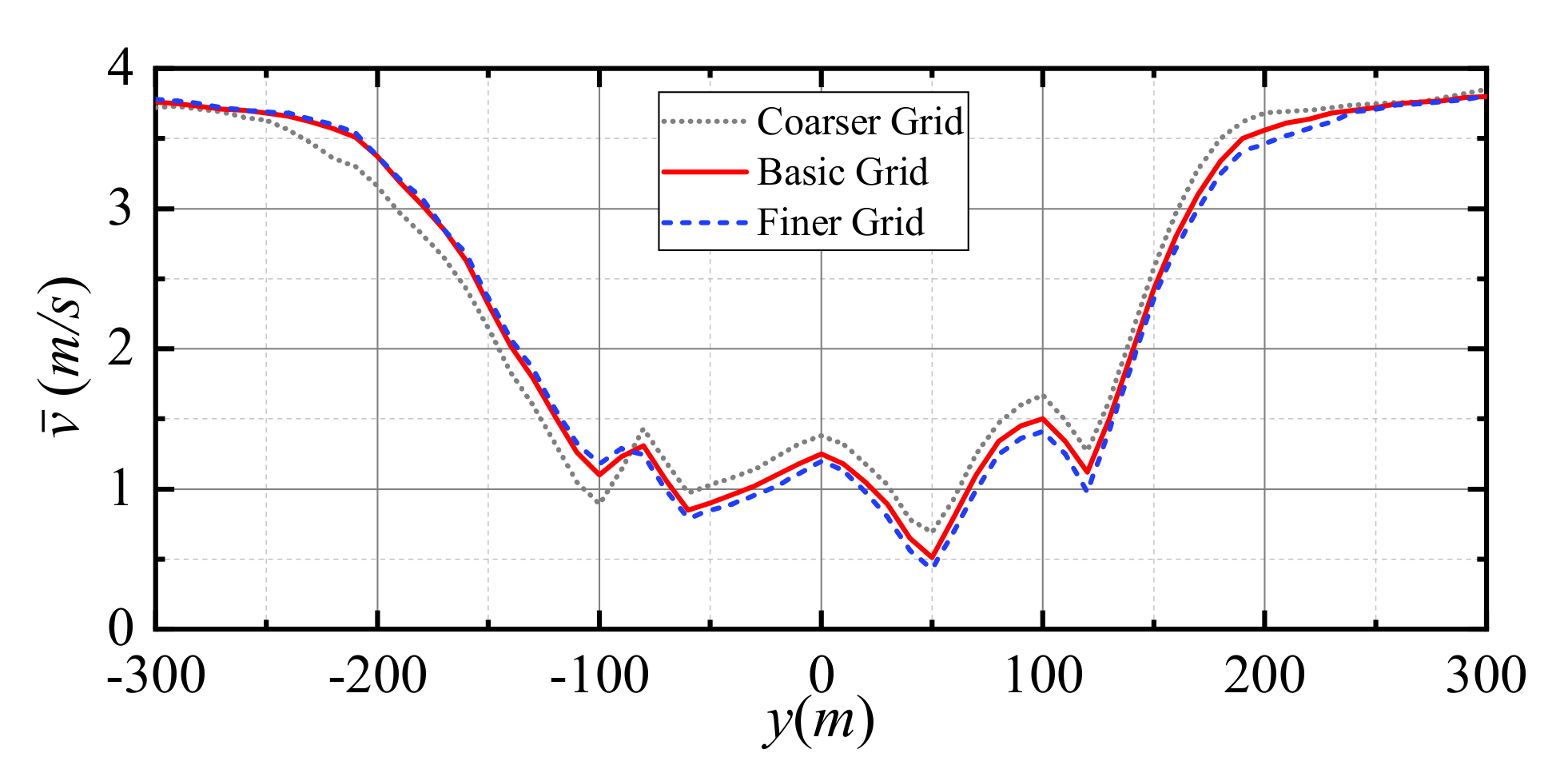
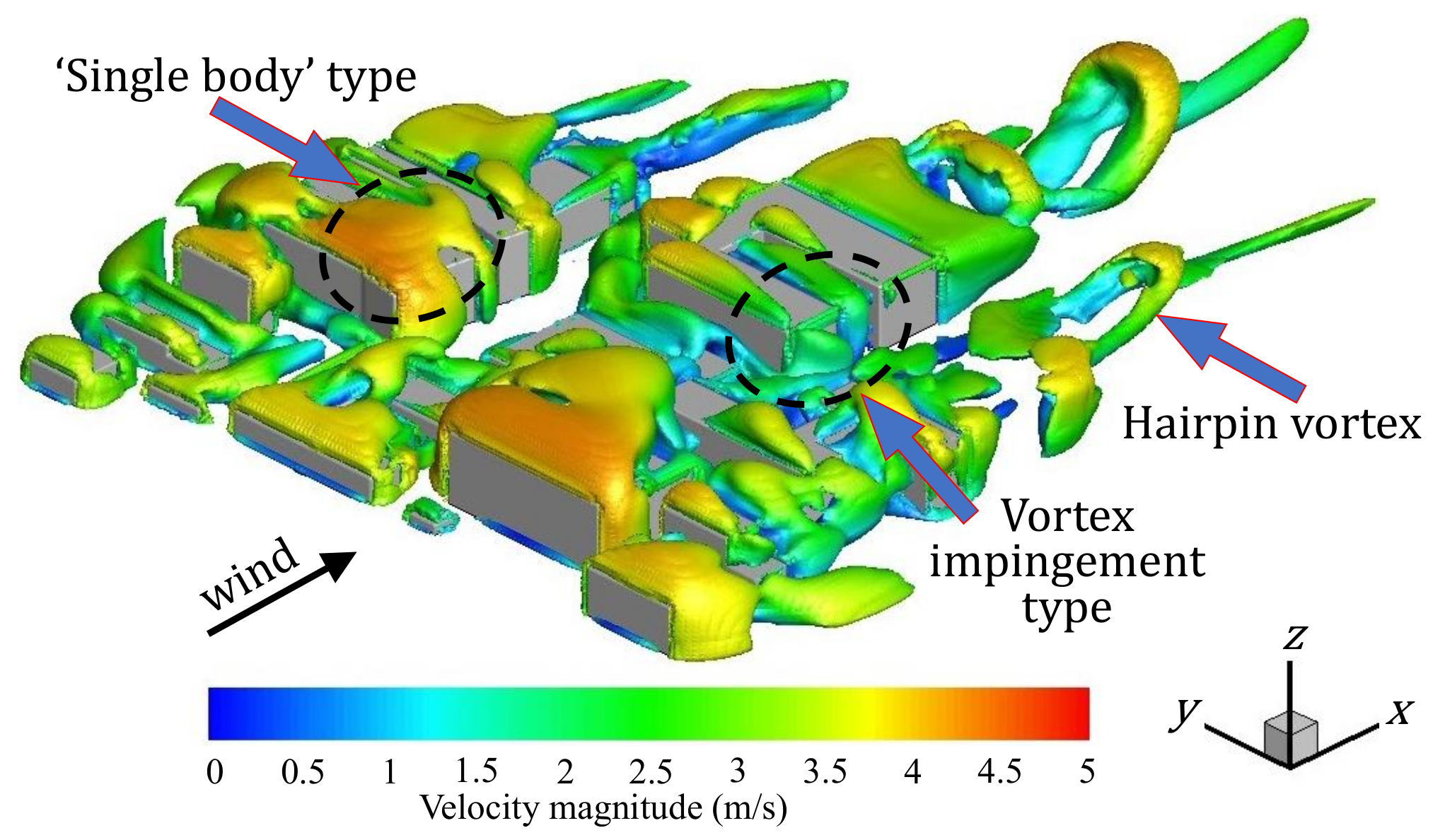

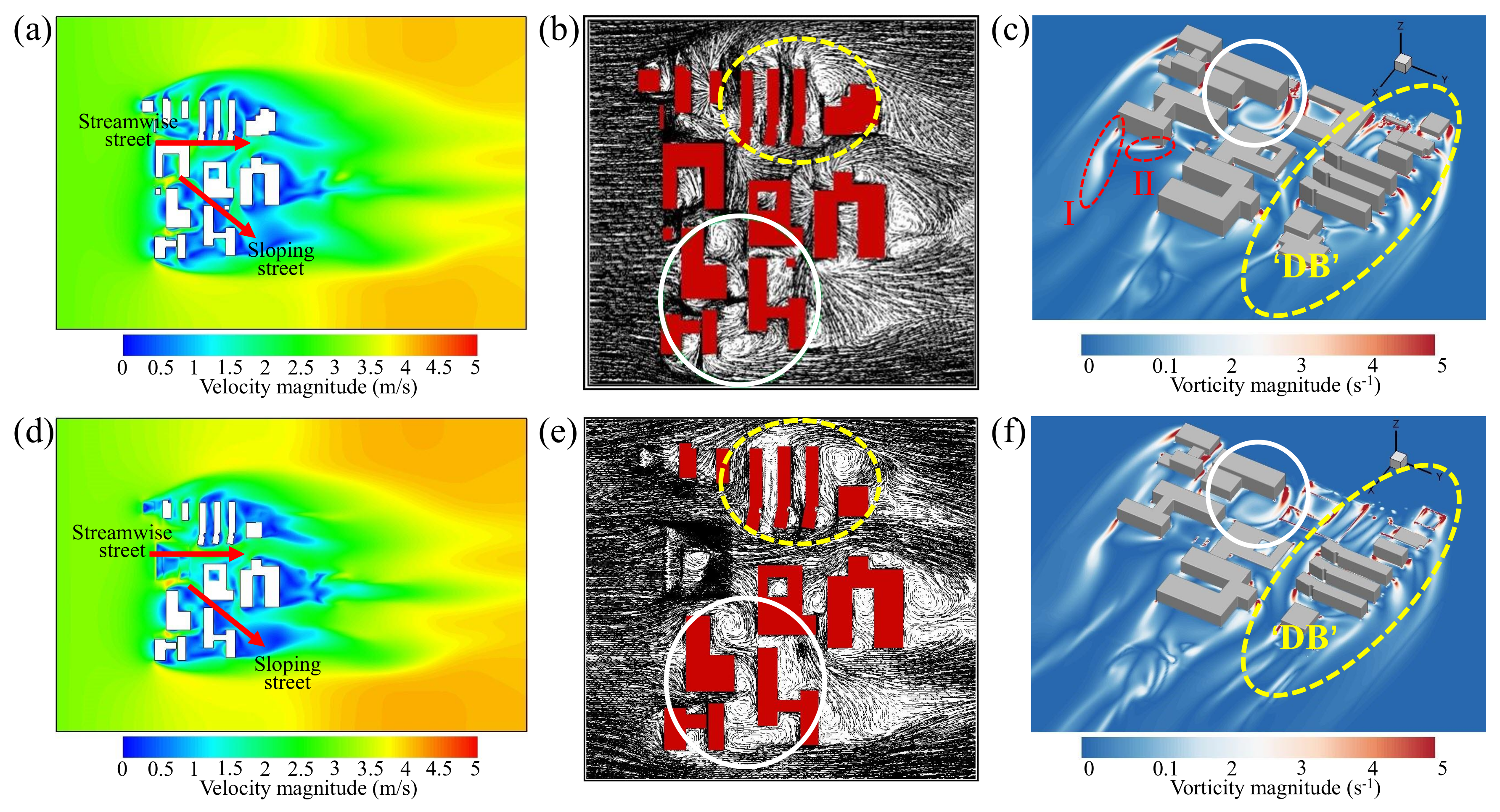
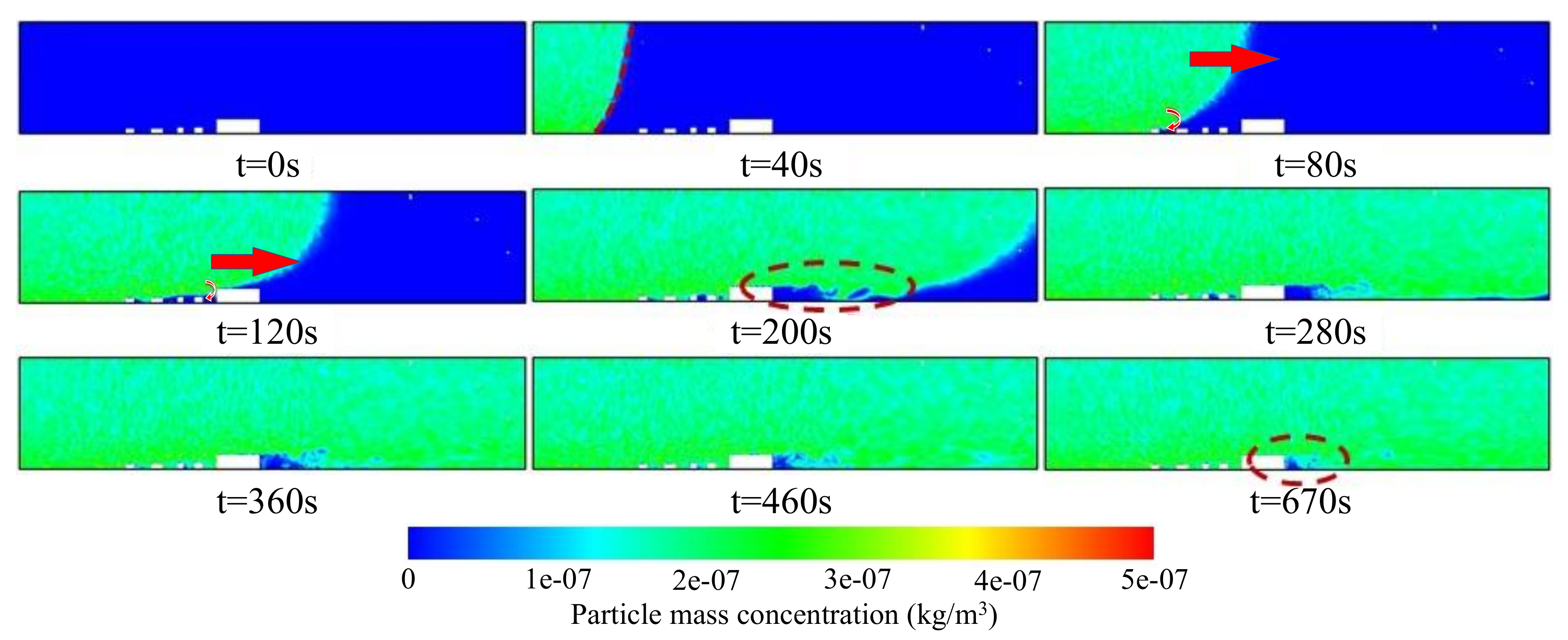

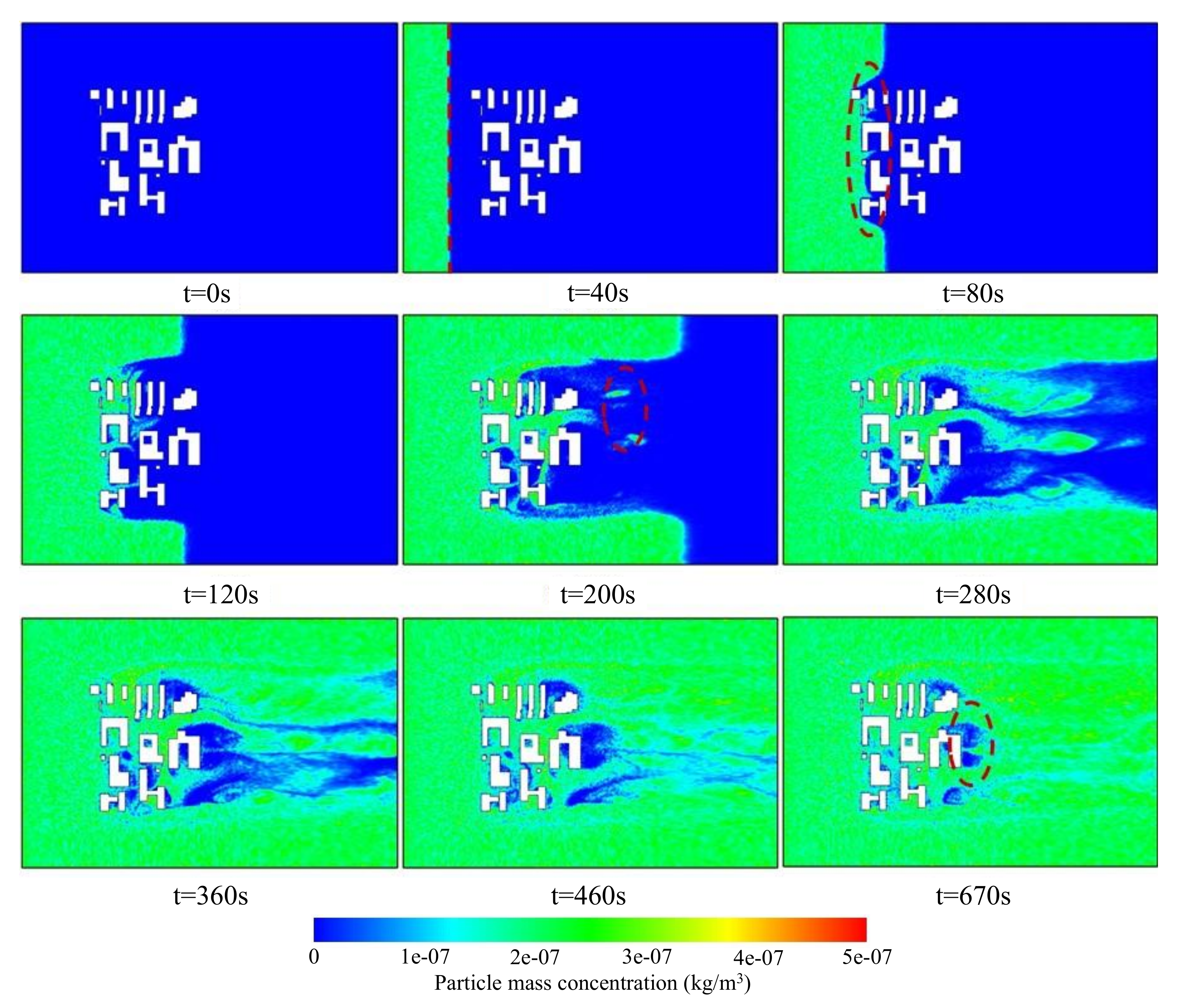
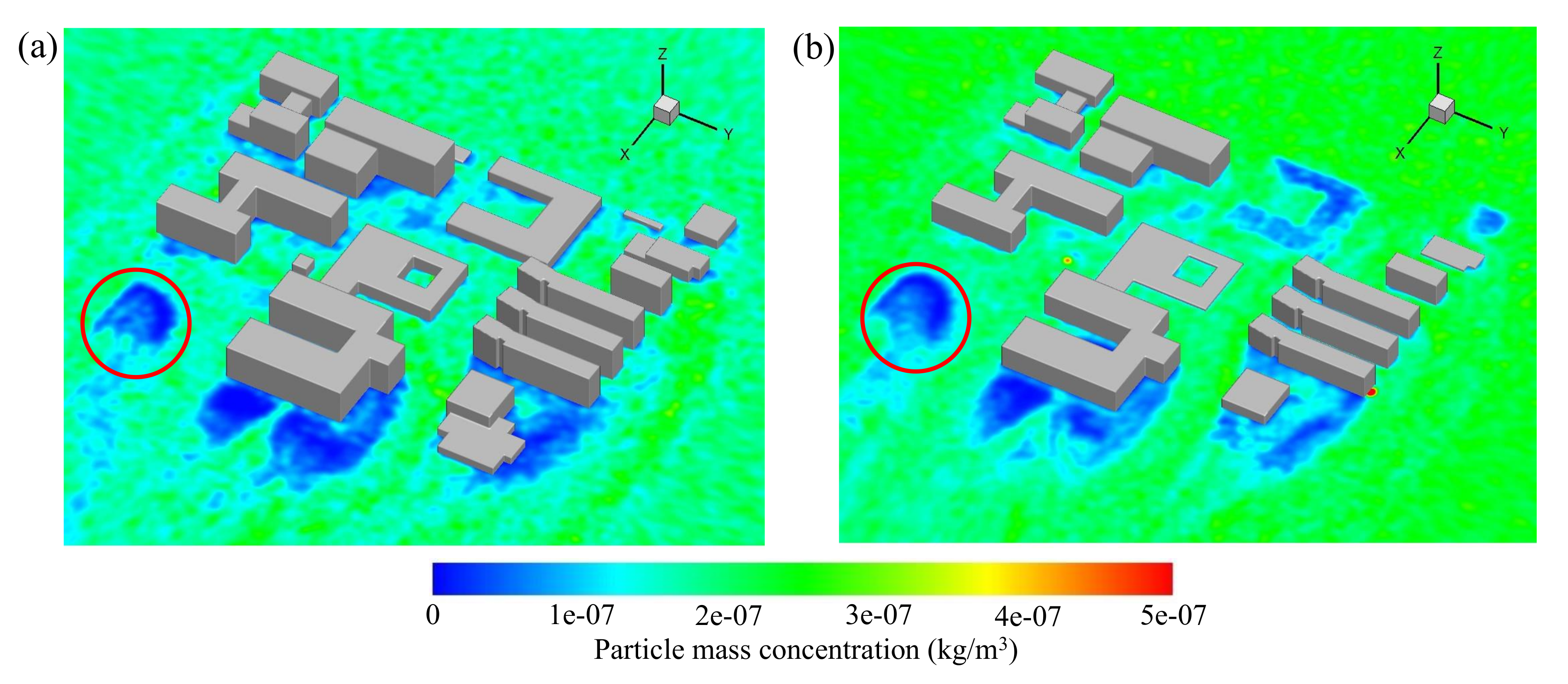
© 2020 by the authors. Licensee MDPI, Basel, Switzerland. This article is an open access article distributed under the terms and conditions of the Creative Commons Attribution (CC BY) license (http://creativecommons.org/licenses/by/4.0/).
Share and Cite
Zhu, H.; Su, J.; Wei, X.; Han, Z.; Zhou, D.; Wang, X.; Bao, Y. Numerical Simulation of Haze-Fog Particle Dispersion in the Typical Urban Community by Using Discrete Phase Model. Atmosphere 2020, 11, 381. https://doi.org/10.3390/atmos11040381
Zhu H, Su J, Wei X, Han Z, Zhou D, Wang X, Bao Y. Numerical Simulation of Haze-Fog Particle Dispersion in the Typical Urban Community by Using Discrete Phase Model. Atmosphere. 2020; 11(4):381. https://doi.org/10.3390/atmos11040381
Chicago/Turabian StyleZhu, Hongbo, Jie Su, Xuesen Wei, Zhaolong Han, Dai Zhou, Xun Wang, and Yan Bao. 2020. "Numerical Simulation of Haze-Fog Particle Dispersion in the Typical Urban Community by Using Discrete Phase Model" Atmosphere 11, no. 4: 381. https://doi.org/10.3390/atmos11040381
APA StyleZhu, H., Su, J., Wei, X., Han, Z., Zhou, D., Wang, X., & Bao, Y. (2020). Numerical Simulation of Haze-Fog Particle Dispersion in the Typical Urban Community by Using Discrete Phase Model. Atmosphere, 11(4), 381. https://doi.org/10.3390/atmos11040381






